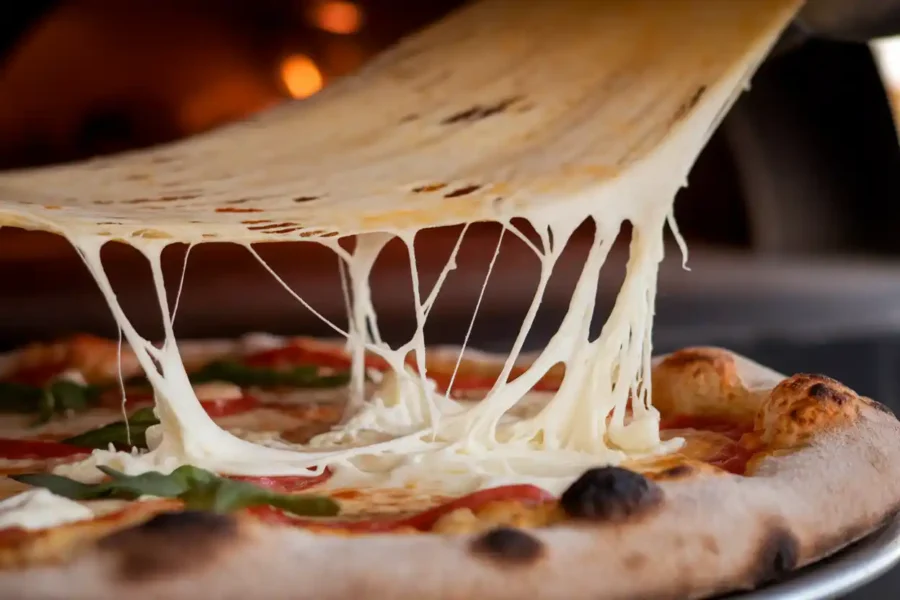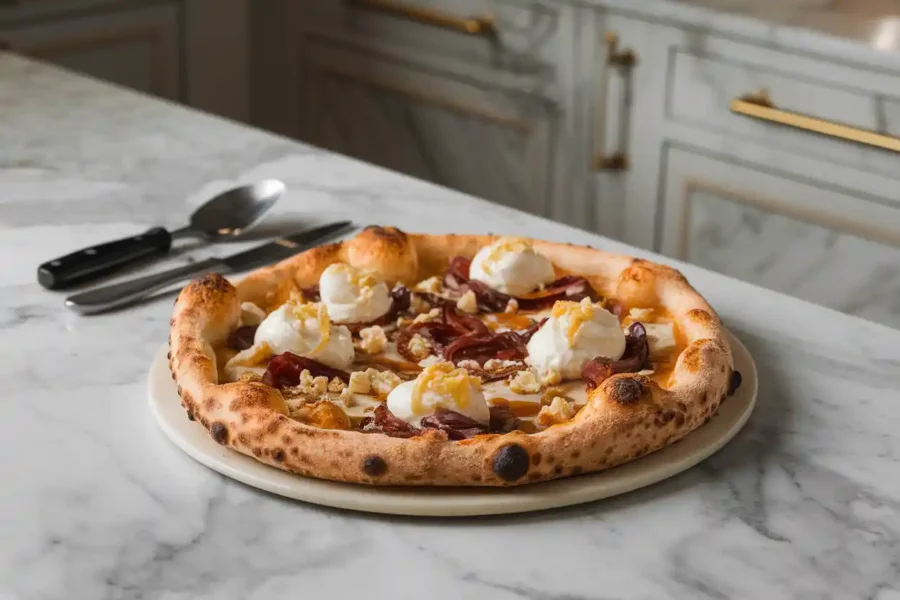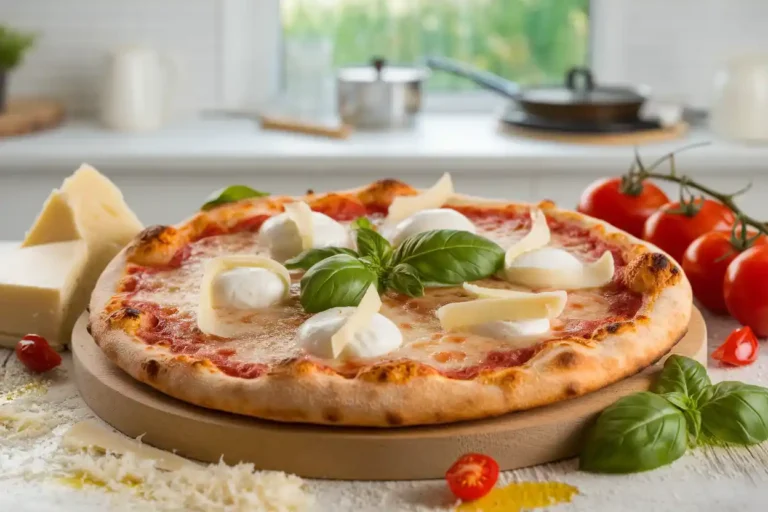When it comes to crafting the perfect pizza, cheese plays a starring role. It’s the layer of melted goodness that binds the toppings together and creates that ooey-gooey stretch we all love. But with so many cheeses to choose from, what cheese works best on pizza? Is mozzarella the undisputed king, or do other cheeses deserve a slice of the spotlight?
In this article, we’ll break down the key factors that make a cheese perfect for pizza, explore popular and alternative options, and even share tips on pairing cheeses for gourmet results. Whether you’re a pizza purist or an adventurous foodie, this guide will help you elevate your pizza game to the next level.
Table of Contents
Understanding the Basics of Pizza Cheese
What Makes a Good Pizza Cheese?
Not all cheeses are created equal, especially when it comes to pizza. The ideal cheese needs to strike a balance between meltability, flavor, and texture. Meltability ensures that the cheese covers the pizza evenly without clumping or burning. Texture adds that satisfying stretch we all look forward to, while flavor ties everything together, enhancing the taste of both the crust and toppings.
Key Factors: Meltability, Stretch, and Flavor
- Meltability: The way cheese melts is critical for achieving that smooth, cohesive layer of cheesy goodness. Cheeses like mozzarella and provolone excel here, thanks to their balanced fat and moisture content.
- Stretch: For that picture-perfect cheese pull, opt for cheeses with elastic textures like mozzarella. Low-moisture mozzarella, in particular, is prized for its stretchiness.
- Flavor: A cheese that’s too mild can get lost among the toppings, while an overly strong one might overpower the dish. Finding the right balance is key. Cheeses like Parmesan and Gouda can be used in small amounts to boost flavor without overwhelming the pizza.
Understanding these factors helps answer the question, what cheese works best on pizza? Mozzarella often tops the list, but there’s so much more to explore. Up next, we’ll dive into mozzarella’s role as the gold standard for pizza cheese. Let’s dig in!
Mozzarella: The Gold Standard

Why Mozzarella Reigns Supreme
Mozzarella has long been the undisputed king of pizza cheese. Its perfect balance of moisture, fat, and elasticity creates the ultimate gooey, stretchy topping. This cheese not only melts evenly but also forms those iconic golden bubbles on top of a piping-hot pizza. When considering what cheese works best on pizza, mozzarella is almost always the first choice.
What makes mozzarella so special? It’s the cheese’s high moisture content and neutral flavor. This combination allows it to blend seamlessly with other ingredients, enhancing toppings without overpowering them. Whether used on a Margherita pizza or a hearty meat lover’s pie, mozzarella remains a versatile favorite.
Fresh vs. Low-Moisture Mozzarella
Mozzarella comes in two main varieties: fresh and low-moisture. Fresh mozzarella, often sold in water-packed balls, is softer and creamier, making it a great choice for traditional Neapolitan-style pizzas. However, its high moisture content can sometimes make the crust soggy if not used carefully.
Low-moisture mozzarella, on the other hand, is firmer and melts more evenly. This variety is ideal for New York-style pizzas, where a slightly crispy crust pairs perfectly with stretchy, melted cheese. Both types have their place in the pizza world, so the choice often depends on the style of pizza you’re aiming to create.
Pairing Mozzarella with Other Cheeses
While mozzarella is fantastic on its own, pairing it with other cheeses can elevate your pizza to new heights. Try combining it with Parmesan for a savory boost, or add a layer of provolone for extra creaminess. Mozzarella also blends beautifully with ricotta, creating a delightful texture contrast.
Exploring Alternative Cheeses for Pizza
Provolone: The Perfect Complement
Provolone is a semi-hard cheese that offers a smooth, creamy melt and a slightly tangy flavor. Its versatility makes it an excellent partner for mozzarella, enhancing the overall flavor profile of the pizza. Provolone’s mild yet distinctive taste makes it perfect for everything from veggie pizzas to barbecue chicken pies.
Cheddar: Adding a Sharp Bite
While cheddar isn’t a traditional pizza cheese, its sharpness can add depth to certain styles of pizza. When used sparingly, cheddar creates a unique flavor layer without overwhelming the dish. It’s particularly well-suited for specialty pizzas like buffalo chicken or cheeseburger-inspired creations.
Parmesan: The Finishing Touch
Parmesan isn’t typically used as a base cheese due to its hard texture, but as a topping, it’s unbeatable. A sprinkle of grated Parmesan after baking adds a nutty, savory kick that complements any pizza style. For those wondering what cheese works best on pizza, Parmesan is an essential supporting player.
Gouda and Havarti: Unique Twists for Gourmet Pizzas
For a gourmet touch, Gouda and Havarti bring something special to the table. Gouda adds a smoky richness, while Havarti’s buttery flavor pairs well with delicate toppings like mushrooms or caramelized onions. These cheeses are excellent for experimenting with new flavor combinations.
Specialty Cheeses: Gorgonzola and Ricotta
Specialty cheeses like gorgonzola and ricotta add sophistication to your pizza. Gorgonzola, with its bold and tangy profile, is perfect for balancing sweet ingredients like pears or honey. Ricotta, on the other hand, provides a creamy, slightly sweet contrast that works beautifully as dollops on top of pizza.
Cheese Combinations for the Ultimate Pizza
Classic Combos: Mozzarella and Provolone
When it comes to what cheese works best on pizza, pairing mozzarella with provolone is a classic choice. The creamy, mild flavor of mozzarella balances beautifully with the slightly tangy profile of provolone. Together, these cheeses create a perfect melt and a harmonious flavor that suits a variety of pizzas, from traditional pepperoni to veggie-loaded options.
To maximize this combination, use a 70:30 ratio of mozzarella to provolone. This blend ensures that mozzarella’s stretchiness remains the star while provolone adds just enough punch to make every bite flavorful. It’s especially popular for New York-style pizzas where bold yet balanced flavors are key.
Bold Blends: Cheddar and Parmesan
For pizzas that pack a punch, blending cheddar and Parmesan is a winning strategy. Cheddar brings sharpness, while Parmesan provides a nutty, savory kick. This duo works well for specialty pizzas like barbecue chicken or cheeseburger-inspired recipes.
To achieve the right balance, use cheddar sparingly as its strong flavor can easily overpower. Parmesan is best sprinkled as a topping after baking, enhancing the final dish with its signature depth.
Gourmet Pairings: Ricotta and Gorgonzola
For a touch of sophistication, consider pairing ricotta and gorgonzola. Ricotta adds creaminess without melting fully, creating a luxurious texture that complements gorgonzola’s bold and tangy taste. This combination is ideal for gourmet pizzas featuring sweet ingredients like figs, pears, or honey.
If you’re curious about experimenting with other cheese blends, check out this article on creamy cheese pairings for more inspiration.

How to Choose the Right Cheese for Your Pizza Style
Neapolitan Pizza: Soft and Fresh Cheeses
For authentic Neapolitan pizza, soft and fresh cheeses like mozzarella di bufala (buffalo mozzarella) are the top choice. This type of mozzarella is rich, creamy, and pairs perfectly with the simplicity of a Margherita pizza. To prevent a soggy crust, ensure the cheese is well-drained before adding it to the pizza.
New York Style Pizza: Stretchy and Flavorful Choices
New York-style pizza demands stretchy, flavorful cheeses. Low-moisture mozzarella is the go-to for its ideal melting properties and stretchiness. Adding a bit of provolone or a sprinkle of cheddar can enhance the flavor without overshadowing the traditional taste.
Gourmet Pizzas: Experimenting with Unique Flavors
Gourmet pizzas open the door to creative cheese combinations. Cheeses like gouda, havarti, and even blue cheese can elevate your pizza with unique textures and bold flavors. These options pair well with exotic toppings such as caramelized onions, roasted vegetables, or truffle oil.
Understanding Regional Cheese Preferences for Pizza
Traditional Italian Cheeses for Pizza
When exploring what cheese works best on pizza, it’s impossible to ignore the classics from Italy. Mozzarella di bufala, ricotta, and Parmesan are staples in traditional Italian pizzas. Mozzarella di bufala, with its creamy, delicate flavor, is the star of Neapolitan pizza, while Parmesan adds a savory kick when grated over freshly baked pies.
Ricotta often finds its place in Italian white pizzas, pairing beautifully with spinach, artichokes, and olive oil. These cheeses emphasize simplicity and freshness, hallmarks of authentic Italian cuisine.
Popular Cheese Choices in the U.S.
In the U.S., pizza styles vary greatly, leading to diverse cheese preferences. Mozzarella remains the top choice for its meltability and stretch, but blends with provolone, cheddar, or even Monterey Jack are common in regional styles like Chicago deep-dish or Detroit-style pizza. American pizzas often prioritize bold flavors, making these combinations perfect for the thick crusts and hearty toppings many prefer.
For those seeking to blend global influences, experimenting with regional cheeses like gouda or havarti can create a unique twist on your favorite recipes.
Call to Action: Experiment with Your Pizza Cheese
Discovering Your Perfect Cheese Combination
Finding what cheese works best on pizza is an adventure in itself. With so many options available, from mozzarella and ricotta to more unconventional choices like blue cheese or vegan alternatives, there’s no limit to what you can create. Start with your favorite flavors and experiment with combinations to find the ultimate pizza cheese mix.
Your Pizza Journey Starts Here
Ready to take your pizza game to the next level? Try combining cheeses for a gourmet twist or stick to the classics for a timeless dish. For more inspiration and recipes, visit TastySara’s collection of pizza ideas. Whether you’re making a simple Margherita or a loaded supreme, the right cheese can make all the difference. Start crafting your cheesy masterpiece today!
FAQs About Pizza Cheese
Is Ricotta Good on Pizza?
Yes, ricotta is an excellent addition to pizza. Its creamy, slightly sweet texture provides a delightful contrast to savory toppings. Unlike traditional melting cheeses, ricotta doesn’t melt completely but softens into luxurious dollops that complement ingredients like spinach, roasted tomatoes, or spicy sausage. For those asking what cheese works best on pizza, ricotta shines in gourmet or vegetarian recipes.
Is Ricotta a Good Melting Cheese?
Ricotta doesn’t melt in the same way mozzarella or provolone does, but that doesn’t mean it’s not useful on pizza. Its high moisture content prevents it from becoming gooey or stretchy. Instead, it blends and adds a creamy texture, making it perfect for dishes like white pizzas or as a topping for flatbreads.
How Do You Achieve Perfect Cheese Stretch?
For that classic cheese stretch, low-moisture mozzarella is your best bet. The balanced fat and protein content of mozzarella make it the go-to cheese for achieving stretchy perfection. Adding small amounts of provolone can enhance the flavor without compromising the stretch.
What’s the Best Cheese for Vegan Pizza?
For vegan pizzas, options like cashew-based or almond-based cheeses offer great meltability and flavor. Brands specializing in plant-based alternatives have developed stretchy, gooey vegan cheeses that work beautifully on pizza. These options are perfect for those who want to explore what cheese works best on pizza without dairy.
Conclusion: The Art of Choosing Pizza Cheese
The Role of Cheese in Elevating Pizza
Cheese isn’t just an ingredient; it’s the heart of a great pizza. The right cheese can transform a simple dish into something extraordinary. Whether you prefer the stretchy, gooey magic of mozzarella or the bold, tangy flavor of gorgonzola, each cheese brings its own charm to the table. Choosing what cheese works best on pizza depends on your style and taste preferences.
Encouraging Creativity in Your Cheese Selection
Don’t be afraid to experiment! Mixing cheeses like mozzarella with Parmesan or cheddar can create unique textures and flavors. If you’re aiming for a gourmet twist, try specialty cheeses like ricotta or gouda to impress your guests. The beauty of pizza lies in its versatility there’s no wrong way to enjoy it.
For more recipe ideas and inspiration, check out TastySara’s curated collection of pizza recipes. Let your imagination run wild, and create your perfect pizza masterpiece!

